How To Create An Online Clothing Store
Content
- Selling clothes online vs. offline: What are the advantages of online stores? Which points should be considered while making an online clothing store business plan?
- How to choose a clothing niche?
- Oberlo
- Amazon
- AliExpress
- Trend Hunter
- What are the e-commerce market clothing trends?
- AI-powered personalization for creating popular online clothing stores
- Thread
- ASOS
- Skechers
- Chatbots
- H&M Bot
- Tommy Hilfiger Bot
- Burberry Bot
- Multi-channel retail
- Oasis
- Garnet Hill
- Marks & Spencer
- How many products are enough to start?
- Clothing store business models
- Print-on-demand - simple way to start an online retail clothing store
- A clothing line from scratch
- Private label clothing store business model
- Dropshipping
- How to choose an e-commerce platform for a clothing store?
- WooCommerce
- Shopify
- Magento
- Shopware
- What platform do we recommend?
- Where does Magento perform best?
- Where does Shopware perform best?
- How much does it cost to build a clothing store and how to sell clothes online?
- Small web store
- Mid-size e-commerce site
- Large web store
- Conclusions
Content
If you are looking for the answer concerning how to start an online boutique, you've chosen a great niche. Selling apparel online is a very profitable business with a $90 billion-a-year revenue.
Statista predicts that apparel and accessories online retail sector in the U.S. will generate about 138 billion dollars in revenue by 2022. At the same time, The United States' apparel market is expected to reach $283 billion in 2022.
Also, the CBRE agency reports that the average returns from e-commerce websites vary from 15% to 30%, compared to an 8% return of the brick-and-mortar store.
Still, the online apparel market is a very competitive one. Currently, key vendors are operating in this market such as:
- Alibaba Group
- Amazon.com
- American Apparel
- Benetton
- Cotton On
- Diesel
- DKNY
- Dolce & Gabbana
- Giordano International
- JD.com
- Levi Strauss
- Rakuten
- Ralph Lauren
- Walmart.
So, what do you need to start an online clothing store and achieve success? For that, you need something more than running online ads and buying a domain. The key to success in this competitive segment lies in selecting a clothing niche, providing high-quality customer service, and choosing the most suitable e-commerce solution.
Have a project in mind?
Lets talk about it
Request a quoteHowever, how to start an online clothing business without wasting budget and time? Precisely how do you choose the niche for your clothing store and the right e-commerce solution? Below you will find all the answers.
Let's start!
Selling clothes online vs. offline: What are the advantages of online stores? Which points should be considered while making an online clothing store business plan?
Setting clothes online has many advantages over selling offline. All of them should be estimated before starting an online clothing store. Let's look at some of them:
- Compared to brick-and-mortar retail, online retail has a lower entry barrier since there is no need to pay rent for a physical space, maintain a physical inventory and pay salaries to the sales representatives.
- Unlike offline stores, e-commerce websites are available 24/7, so online retailers could run their business without days-off, lunch breaks and holidays.
- Online retailers can track shoppers' interactions with their e-commerce store across different platforms and analyze their behavior.
- Online customers enjoy online shopping since it allows conveniently buying items without leaving their home or office.
As we said, to create a successful online clothing store, the first thing to do is to select a clothing niche. If you have not done it before, do not panic. Below we will tell you how to open an online clothing store in the right way and what websites could help you with that.
How to choose a clothing niche?
Your future clothing niche will have a direct impact on your future business plan, your potential buyers and the way you will position your online store. For that, choosing a niche is a critical step.
However, before choosing it, you should consider the following information:
- Your online clothing store should stand out from the crowd since the online apparel market is very competitive.
- For starting an online clothing business, you need to select the clothing niche which you are passionate about.
- Another thing to consider is that the future niche should be in high demand and bring profit to your online business.
When choosing the niche, you can use websites such as Oberlo, Amazon, and AliExpress to get insights into trending clothing categories. Let us show you how it works.
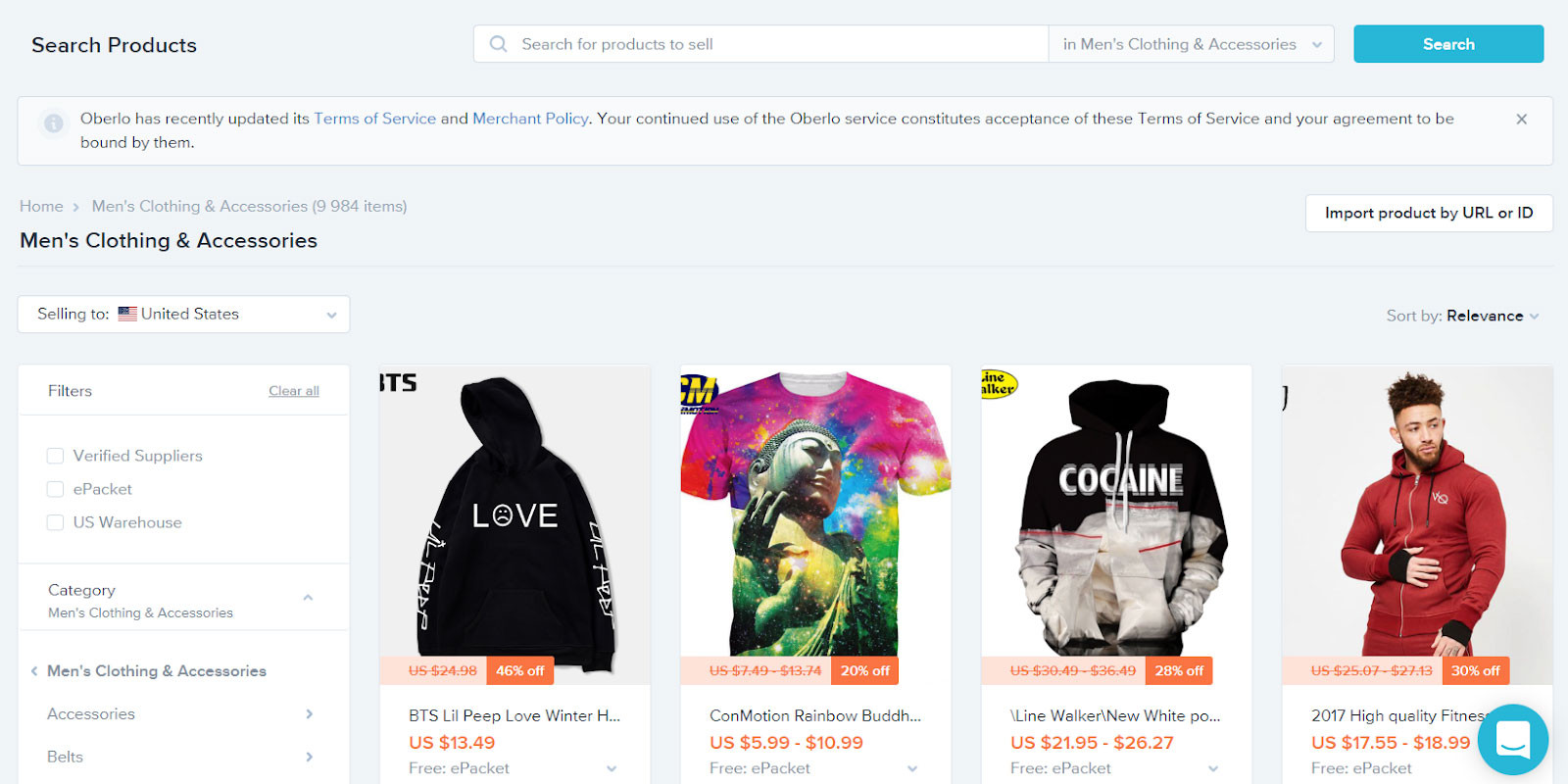
Oberlo
Oberlo is a website where online retailers find wholesale suppliers. Such websites with online wholesale clothing stores you can use for conducting trending product research. For that, you need to sign up to the site and use the "Popular" section to receive insights into trending apparel categories.
Now, the most popular niches for women's clothing are intimates, dresses, and bottoms. For men's clothes, the most popular segments are jeans and t-shirts.

Amazon
When looking for a niche, you can visit Amazon's Quirky & Unique section to see anything that stands out. If you want to do even more in-depth research, you can look at specific product collections. Remember that Amazon search is personalized and keeps the focus based on your interests. Keeping the focus on your interests could be good for you while starting your own online clothing store because in this way you can create a business based on your passions.
Currently, the most trending products in the Clothing, Shoes & Jewelry category are men's jeans, women's jeans, and underwear.

AliExpress
To find the niche for your future clothing store, visit the Bestseller section at AliExpress. Remember that the top ten most trending products are very competitive. You can also use intuition when trying to come up with a niche to start an online store. When deciding on what to sell, we also recommend looking at order volume before making an online clothing store business plan.
Now, the most popular categories at AliExpress are dresses, blouses, t-shirts, and hoodies.
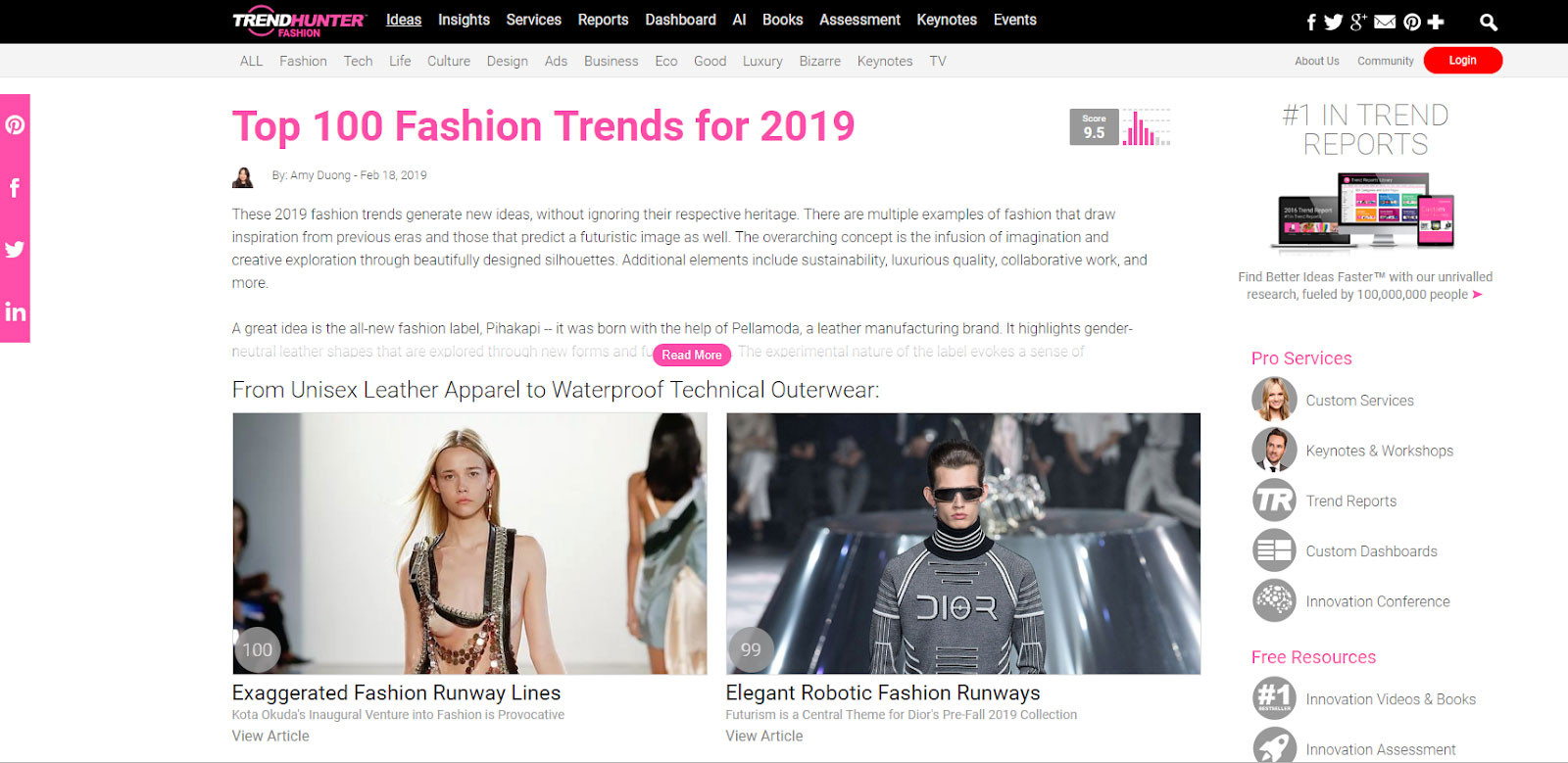
Trend Hunter
Additionally, here is a bonus section for your future success. When deciding on the clothing store niche, we recommend using the Trend Hunter website. This website collects top trend ideas, in particular for an online apparel store. Using this website, you can find fashion collections that are currently trending among online shoppers. Such kind of review is a necessary point when you decide to start own clothing store online.
Presently, popular fashion categories include colorful sneakers, stylish cyclist breathing masks, sports bras, and outerwear with minimalistic designs.
What are the e-commerce market clothing trends?
If you selected your future apparel store niche, it is time to receive insights into current online clothing trends and learn how to start an online clothing store. Being aware of modern and trendy e-commerce solutions is a significant advantage since your online clothing store would meet customer expectations. Below we share the list of top technological trends in the online fashion market which are used by the best online clothing stores.
AI-powered personalization for creating popular online clothing stores
Artificial Intelligence has become widespread in the fashion market. It is supposed three-quarters of online fashion merchants to invest in this technology over the next two years. AI allows providing customers with a personalized online shopping experience. There is no more time wasted looking through irrelevant products due to this technology. Shoppers have an opportunity to find the product they like quickly and that increases conversions. This technology for the "You may also like" sections can be also used in your future online boutique.
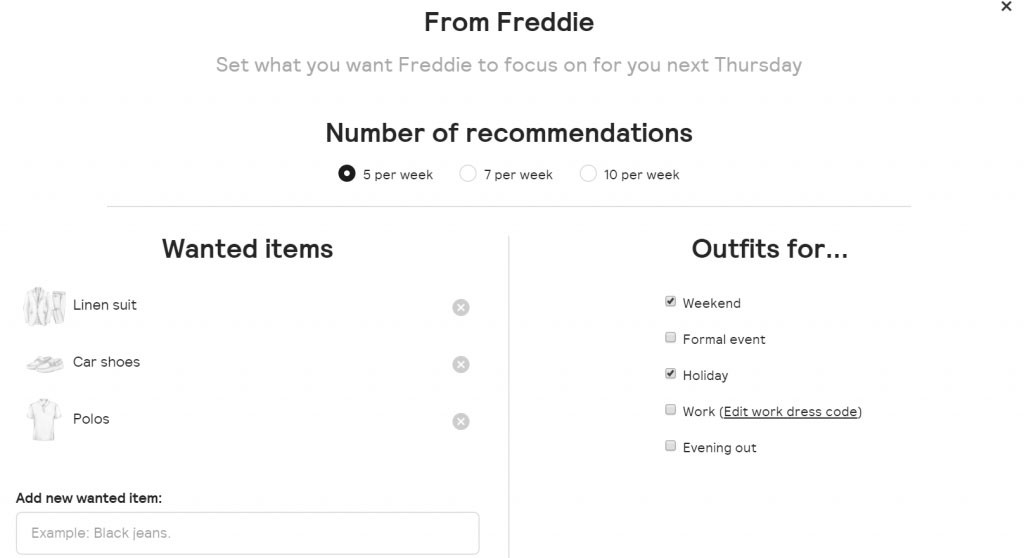
Image source: Clickz
Thread
One of the fashion brands currently using AI technology is Thread, a UK-based fashion retailer, launched in 2012. Its primary function is to pair customers with stylists and create tailored recommendations every week according to the customer's stylistic preferences.
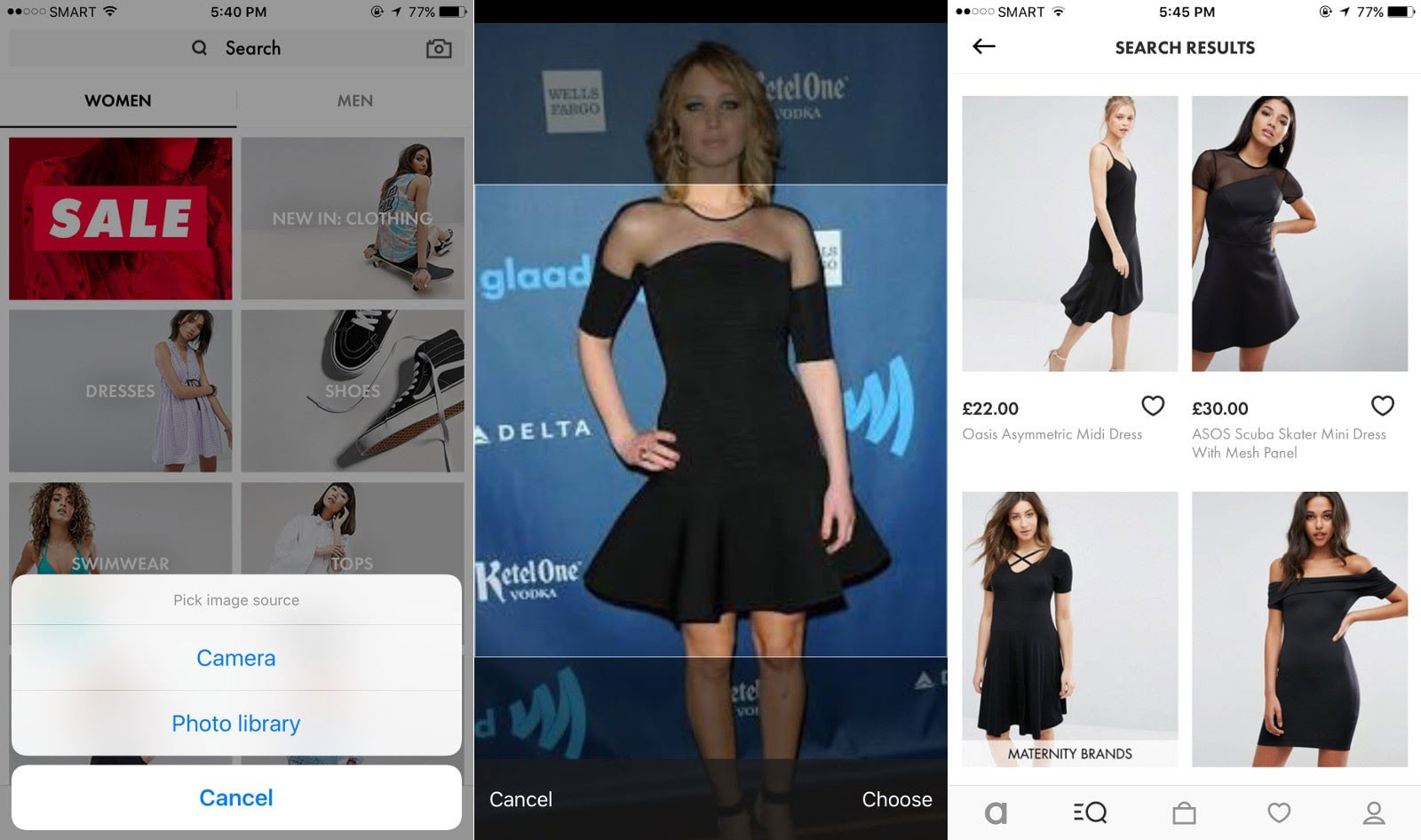
Image source: Engadget
ASOS
ASOS Visual Search is another example of a successful AI-powered personalization. It improves the shopping journey in online clothing boutiques by making personalized recommendations to consumers before they even know what kind of product they want. ASOS visual search turns the user's smartphone camera into a discovery tool, allowing them to take a picture of a product. By identifying the shape, color, and pattern of the object, ASOS' AI technology can then cross-reference its inventory of products and serve up the most relevant results.
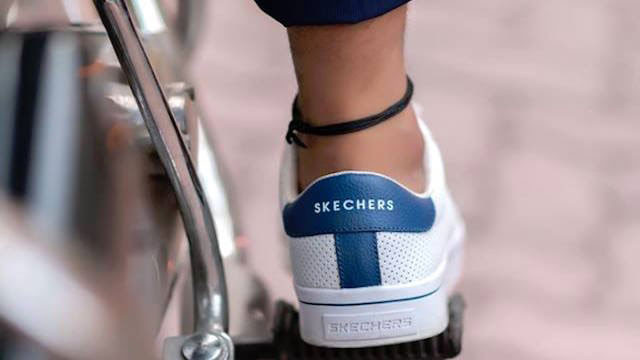
Image source: Insideretail
Skechers
Skechers, a shoe retailer, who uses AI to offer online shoppers with the most relevant products according to their lifestyle. As online shoppers click on a product they're interested in, AI-powered tools analyze the Skechers catalog in real-time to serve up similar or related items. This way, AI provides a seamless and intuitive shopping experience for customers and helps to explore the products they want — boosting both customer satisfaction and sales.
Chatbots
Chatbots, powered by AI, direct customers towards relevant deals and products, while helping them to identify products they might want or need. This way, they drive sales and online business revenue. Facebook Messenger, for instance, is one of the most popular platforms for chatbots in the fashion e-commerce industry. Using this platform, fashion brands and online clothing stores communicate with their current and prospective customers. Some of the top fashion retail brands like H&M use bots that allow shoppers to customize shopping experiences and buy products.
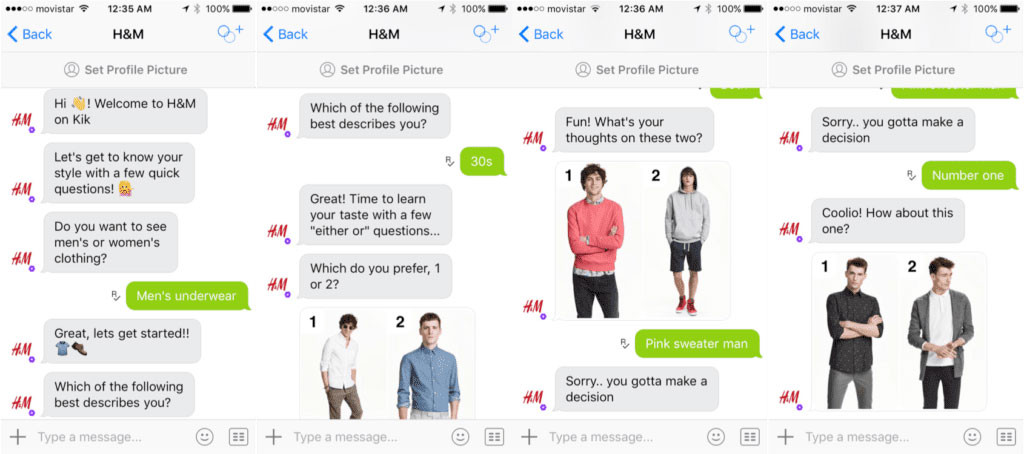
Image source: E-commerce-chatbots
H&M Bot
Kik messaging app, developed by H&M clothing retailer, allows online shoppers to see, share and purchase products from H&M's catalog. This chatbot works as a personal stylist service. It uses photo options and asks questions about shopper's style preferences. Then, the bot creates a comprehensive profile of how shoppers want to look. This way, customers can create their outfits, vote, and browse ensembles created by other users. Such an approach can definitely increase the income of eCommerce clothing store.

Image source: Chatbotguide
Tommy Hilfiger Bot
Tommy Hilfiger is an American apparel and accessories brand that prefers the Facebook Messenger platform for its chatbot. The bot shows the consumer the collections and gives three options for the conversation, such as style advice, browsing, or a behind-the-scenes look from the latest fashion shows. This bot demonstrates excellent language processing ability during a conversation and proposes a list of options to choose from.
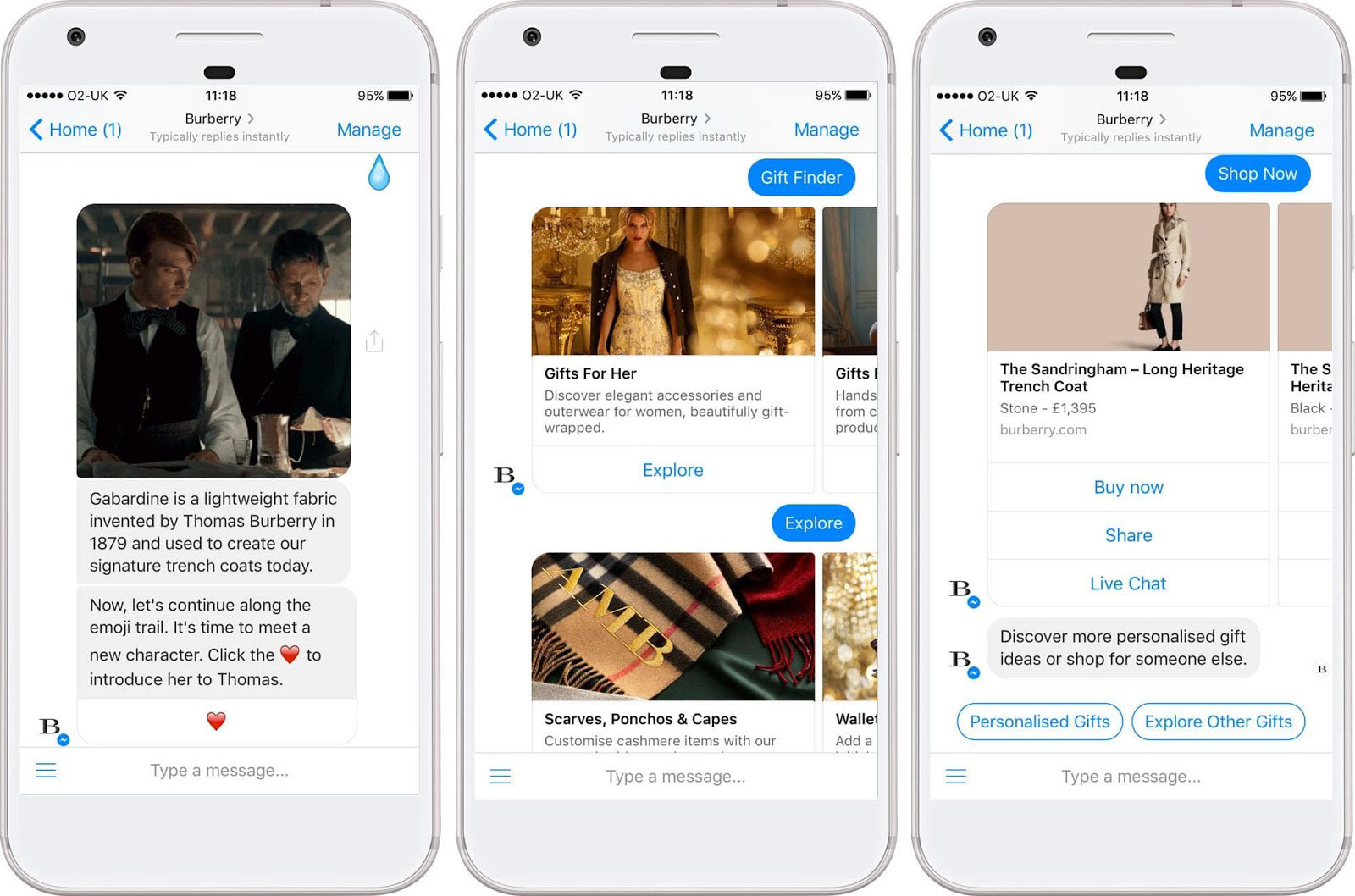
Image source: Chatbotguide
Burberry Bot
The bot, developed by a luxury clothing brand Burberry, is also powered by Facebook Messenger platform. The chatbot shows customers the brand's latest collection of bags. With the 'Discover More' feature, the chatbot lets shoppers browse the collection, get to know more about the craftsmanship, or find out how to style a bag with Burberry's apparel and accessories. Burberry's chatbot offers pre-made suggestions that guide users through their shopping experience. Such a chatbot could be a great choice for online clothing stores that accept PayPal.
Multi-channel retail
Multi-channel retail is a hot trend among fashion retailers, who want to be more customer focused by offering customers a multi-channel experience. The multi-channel approach is about promoting and selling anywhere customers can go and buy. This strategy applies to various channels including social media, messaging apps, marketplaces, and online communities – everywhere your target audience exists and no wonder it is used by the most popular online clothing stores.

Image source: Oasis
Oasis
Oasis, a U.K. fashion retailer, uses e-commerce sites, mobile app, and brick-and-mortar stores as one sale funnel and provides customers with a straightforward shopping experience. All sales associates in offline stores are armed with iPads to give you on-the-spot, accurate, and up-to-date product information. They use iPads as a cash register, making it easy to ring you up from anywhere in the store. Moreover, the staff can instantly place an online order for you to have the item shipped directly to your home, so it's a great decision for online clothing stores with fast shipping. Also, customers can download the Oasis' app to supplement their in-store (or online) shopping experiences, too.
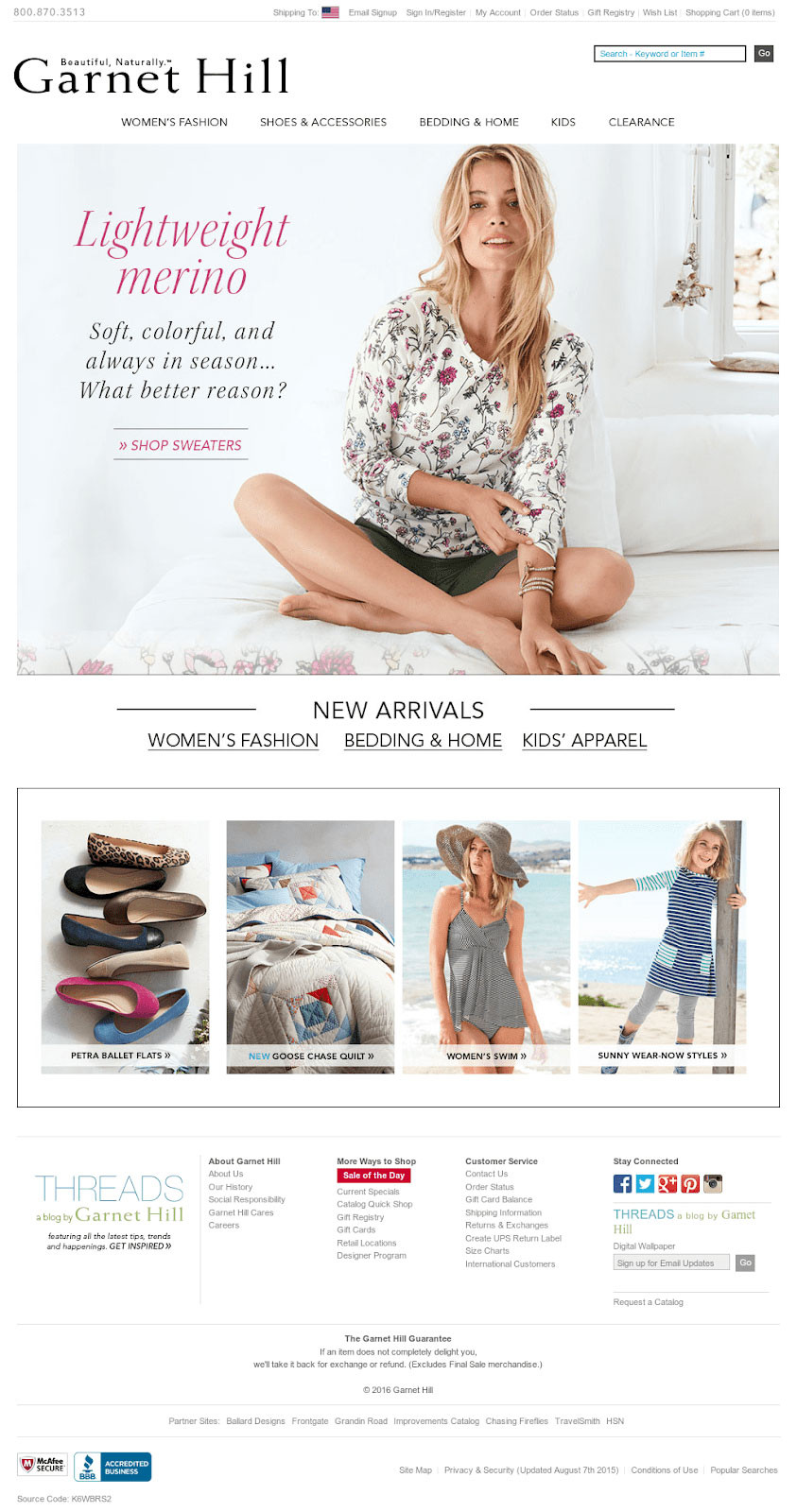
Image source: Owler
Garnet Hill
Garnet Hill, a specialty apparel and home decor retailer, is also a great example of multichannel success. The company launched a mobile website, empowered with e-commerce functionality and the ability to search for items using source codes from the printed catalog on their mobile phone. The mobile site also allows users to employ a full product search, check order status, and browse deals of the day.

Image source: Etaileurope.wbresearch
Marks & Spencer
Marks & Spencer fashion retailer also uses a multichannel strategy. The company launched the mobile website as a fully integrated channel alongside the Web online shop version. As a result, the mobile site drives sales and quickly gets the product into the hands of its customers. The company has increased order sizes and conversions by allowing shoppers to log into their regular Web account and complete transactions from their mobile devices and vice versa. So, a multichannel strategy is definitely a great idea for eCommerce clothing websites.
Since you are aware of the clothing website's current trends, it is time to move on and start planning a clothing online store launch.
How many products are enough to start?
When you decide to open your first online boutique, it is better to start small and simple. Adding a huge amount of items to your catalog, could become the reason for extra admin costs and add additional complications to your first launch. Getting too many orders, you won't be able to handle them without outside help. Therefore, you may have delays in delivery that lead to poor customer service. That can break your clients' trust and become the reason for business crashing. Ever-changing fashion trends are another reason to start small. The best choice is basic products which can be quickly changed to suit changing fashion trends. We recommend to set focus and be as narrow and specific as you can from the very beginning. We also advise you to think about where you see your e-commerce clothing store expanding in the future and focus on the end goal of creating a unique online clothing store. With this strategy, as your store grows in the selected niche, you can add new or trending products to your catalog more seamlessly.
With this in mind, let us discover the most popular business models and how to start selling clothes online.
Clothing store business models
There are four main types of business models for online clothing stores. There are print-on-demand, custom cut-and-sew, private label clothing lines and dropshipping. Each of them has its advantages and disadvantages. Below we describe them in detail so you can decide which one will work the best for your future online clothing store.
Print-on-demand - simple way to start an online retail clothing store
This business model is the best when you need to launch an online apparel store as quickly as possible within the limited budget. Print-on-demand is the most straightforward business model since the only thing a company does is printing design on a blank version of products using a digital ink-jet printer.
The main advantage of print-on-demand business model is that it is effortless and cheap in implementation. It suits small companies that deal with small amounts of orders.

Image source: Shopify.com
An example of an online apparel store that operates this business model is Printify. Printify is well known among other online businesses as an original print on demand e-commerce website because of its wide range of products. Customers can choose from categories like men's, women's, and kids clothing and then, customize products with logos and prints.
The main disadvantage of using this business model is a low-profit-margin. Therefore, if you want to start your own online clothing store and are looking for a business model that will bring you a huge profit, you should look for something else.
A clothing line from scratch
This business model suits businesses who want to develop and launch their clothing brand from scratch. This way, online retailers design and manufacture products.
The main advantage of a clothing line from scratch business model is that you have an opportunity to create an online clothing store that would be especially unique and outstanding. Such a business model could be also aimed at starting your own clothing brand.
Its drawback is in the amount of management needed. You will be responsible for finding and coordinating the pattern makers and manufacturers, as well as sourcing your fabric.
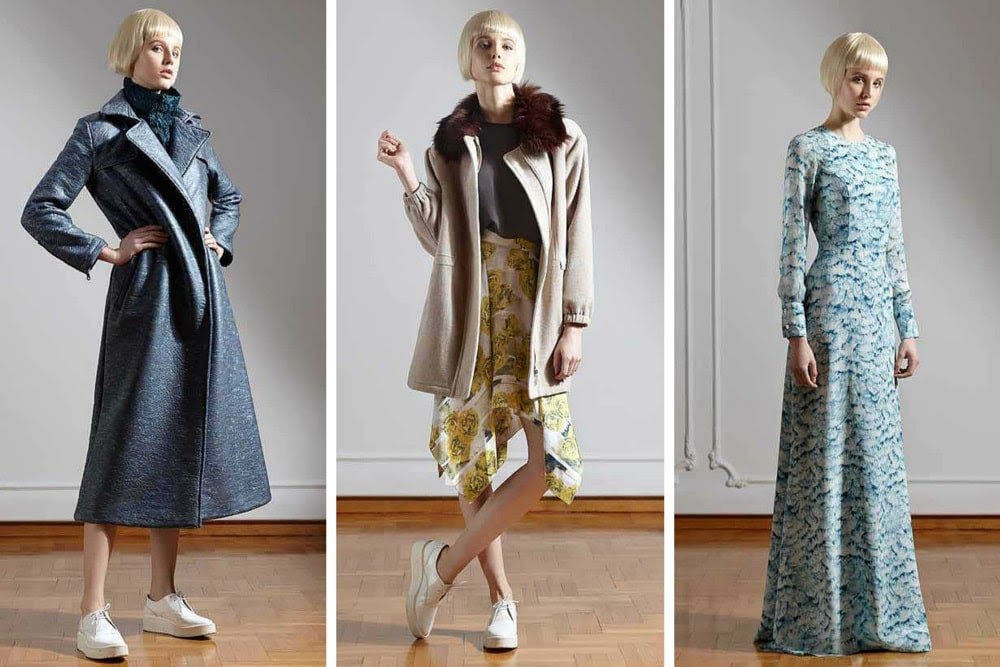
Image source: Fafafoom
An example of a brand that uses this business model is Christina Economou. After attending Parsons and Istituto Marangoni in Paris, her graduate collection won the 2011 International Award at London Graduate Fashion Week. Then, she decided to fulfill her dream of launching her label. In her collections, she reflects her own effortless and eclectic style. The result of her work is an online clothing boutique that presents a fashion line of fresh and progressive clothes. She dreamed of creating a line that offers a sophisticated twist on a classic day and nightwear. For her clothing line, Christina uses beautiful printed silk fabrics made according to an age-old tradition in the historic silk town of Soufli in Northern Greece.
Private label clothing store business model
Private label business models are something between print-on-demand and cut-and-sew. While using this business model, at first your aim is to focus on a particular product line and then find a private label-clothing manufacturer to create your own clothes. This kind of business model gives you less 'work' and expenses than cut-and-sew, but, at the same time provides more customization than print-on-demand.
The private label business model can be described as a process when you buy label-less clothing items and after add your label, custom design, or tag.
Still, this business model has its drawback. While using the private label, you have to deal with fulfillment and inventory management yourself. However, you can streamline the process using e-commerce platforms, as Threadbird, where you can buy and custom-finish your apparel and clothing.
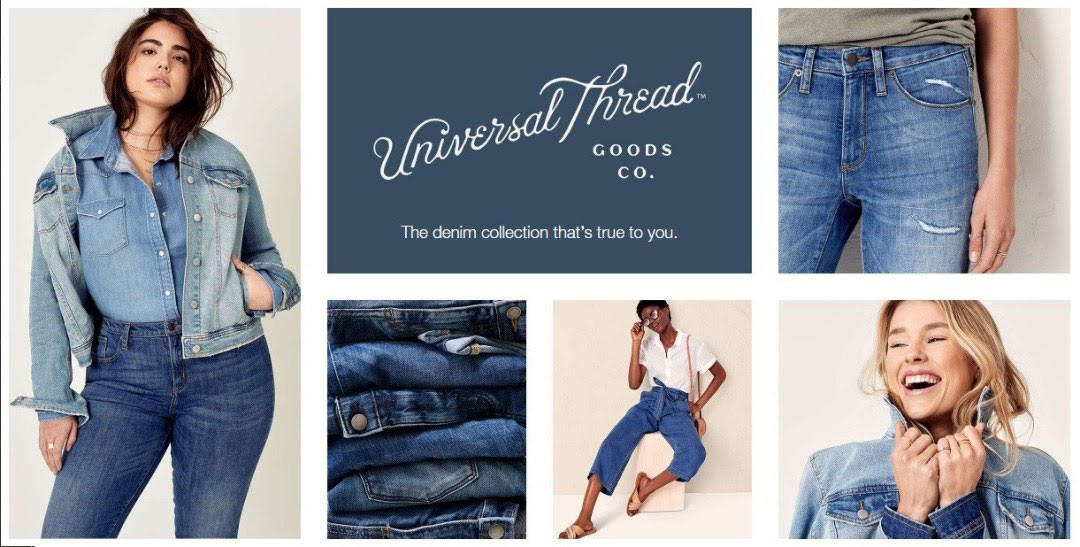
Image source: My9to5shoes
One of the fashion brands that use this business model is the Universal Thread. The company's main niche is women's lifestyle denim. Still, their product catalog also includes dresses, tops, shoes, and accessories.
Dropshipping
Similar to print-on-demand, a drop shipping business model allows you to sell clothing from wholesalers. Dropshipping is a budget-saving business model since you don't have to deal with buying stock up front, storing, packing or shipping.
The main advantage of running a drop shipping apparel store is that you do not need any capital to start. You can use the Shopify platform with an integrated dropshipping plugin to provide your customers with clothing right from wholesalers.
At the same time, using the dropshipping model has its disadvantages. With this model, it is impossible to develop your unique brand since there are hundreds of online stores selling the same products as you.
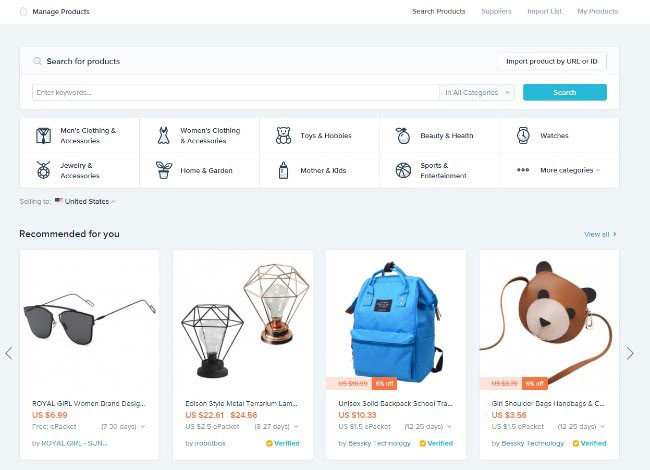
Image source: Ecommerce-platforms
As we said, no famous brands are using the drop shipping business model. Nevertheless, as an example, we can look at Oberlo, the biggest e-commerce platform for wholesalers. If you have decided to run a drop shipping online store, you can easily find the suppliers on Oberlo platform. It is a marketplace to search and find clothes to sell online at your online boutique. Oberlo connects merchants with suppliers, who then ship products directly to buyers.
If you are wondering how to start an online fashion boutique, keep reading. Below we discover modern e-commerce solutions for your future fashion online shop.
How to choose an e-commerce platform for a clothing store?
Before choosing the e-commerce platform for your future online store, you need to consider the following:
- Stock size
- Payment gateway
- Traffic volume
- SaaS or open-source solution
- Platform payment plan
After reviewing the following parameters, it would be easier for you to choose the solution that is the best for your business.
Below we share out top four e-commerce platforms powered with all the necessary features for running a successful online boutique.

Image source: Design Bombs
WooCommerce
WooCommerce is a free WordPress plugin, well known in the world of e-commerce. The platform comes with a shopping cart and a secure payment gateway out of the box. You can increase the functionality of your future website with free and paid plugins and modules. When opening a clothing store online, you can choose from paid and free website templates created for the fashion business, or hire an e-commerce team to develop a custom web design. It is an excellent solution for small businesses, but if you expect to handle significant traffic, you should look for something more advanced.
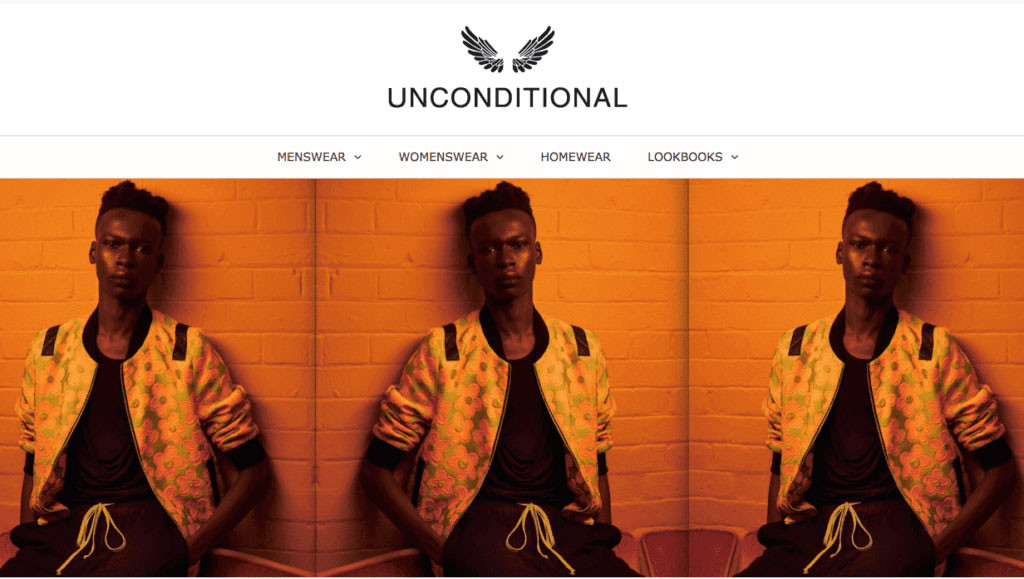
Image source: Oberlo
Shopify
Shopify, a Canadian-based e-commerce SaaS platform, powers many online shops across the globe. The platform keeps a sharp focus on mobile shopping and trending social commerce. Shopify provides users with several paid plans:
- 'Basic Shopify' - $29 per month
- 'Shopify' - $79 per month
- 'Advanced Shopify' - $299 per month
- 'Shopify Plus' - around $2000 per month.
You can choose the best one that suits your fashion online business goals. What is more important, the platform has useful apps, developed for fashion online store owners. With these applications, you can add customer photo reviews to product pages, provide customers with personalized recommendations, allow users to try on jewelry virtually by uploading photos of themselves, and more. The platform has a user-friendly admin panel, so even a beginner in online retail can take benefits from it.

Image source: Swissuplabs
Magento
Magento is an advanced open source e-commerce platform that suits small and enterprise-sized businesses. If your fashion online boutique catalog includes multiple products and the website is expected to handle large traffic, this is your future e-commerce platform. Magento is a reliable and scalable solution for clothing boutiques online, used by famous brands, like Burger King, Huawei, Pepe Jeans, and Liverpool F.C. As Shopify, Magento pricing range varies:
- Magento CE (Community) - Free
- Magento EE (Enterprise) - Starts at $22,000 per year
- Magento EE Cloud - Starts at $2000 per year (includes hosting).
If you plan to create an Enterprise level online store with a massive amount of products, this is your solution.
Still, to set up and run a fashion store on Magento, you will need help from e-commerce developers since the platform has highly technical management requirements.
The cost of developing a site on Magento, like any other, depends on the set of necessary functions and additional modules. And there are also several levels of complexity. Let's review them:
- An online store operating in one country with one target audience (the prices fluctuate between $ 6,000-10,000)
- A set of similar sites for different countries, in different languages and at different prices (the cost will already be $11,000-20,000)
- An eBay-style e-commerce platform (this option is the most time consuming to develop, its cost starts from $ 20,000, and even we cannot name a rate limit).
If you are interested in the third option we suggest reading our guide on how to develop a website like eBay.
Shopware
Shopware is a powerful and tunable software solution. Due to high flexibility, it allows you to quickly and easily create online stores. Covering over 18,000 customers, it rapidly became one of the most popular e-commerce tools in the European market, which is definitely an excellent choice for creating unique online clothing stores.
Thanks to the intuitive interface and easy-to-use backend of the software, it became the optimal choice for users, decision-makers, designers as well as for developers. It is available in different editions, so you're guaranteed to find the right solution for your fashion store. Accordingly, the price range varies:
- Starter Edition - Free
- Professional Edition- €199.00 per month
- Enterprise Edition - On Request
Shopware is based on emerging e-commerce technologies and provides a highly-innovative marketing tool foundation for successful online business. The cost of developing a site in Shopware depends on the capabilities you want. Developing a Shopware-based store could cost from $2,000 to $15,000 on average.
What platform do we recommend?
As e-commerce professionals, for the development of an online boutique, we recommend using Magento or Shopware. These platforms are the best solutions if you are determined to create online clothing store. They are powerful and flexible enough to fit all possible ecommerce website requirements. Security is guaranteed too. The developers regularly test Magento and Shopware for vulnerabilities and release patches that improve security. We choose Magento or Shopware depending on the website to develop. So, let's review the occasions where it's better to choose each of them.
Where does Magento perform best?
Magento is a flexible and versatile platform, which is the best choice for online stores with a large number of products (over 10,000). Magento also makes it possible to create several online stores, and manage them from one administrative panel, which is certainly very convenient.
Where does Shopware perform best?
Shopware is a great e-commerce solution that is potentially able to suit all retailers - from startups to enterprise.
However, it is a better choice for small and medium-sized companies. Shopware is cheaper, easier to set up, it boasts a more intuitive interface, and provides some unique features.
With this in mind, let's see, how to start an online business for clothing with the development team and how much it will cost.
How much does it cost to build a clothing store and how to sell clothes online?
As we said, there are free and paid e-commerce platforms. Still, if you are not a technical person, we recommend hiring a development team for setting the online apparel store. It is a more convenient and safe option because professional developers will help you with the payment gateway, features integration and quality assurance of your online boutique.
If you have not found the desired e-commerce solution described below, you can hire a team for a custom fashion store development. We, a team that knows how to make a clothing website, divide online stores into three types based on their complexity. Below we describe their main features and give the approximate estimated cost for each website type.
Small web store
Three main aspects determine a small online store: a small product catalog (100-1000), small traffic, and a basic design. Still, such a website has everything for successful online trading, like the shopping cart and payment gateway.
Estimated cost of custom development: $15,000 – $20,000.
Mid-size e-commerce site
This is a more advanced type of e-commerce website with average product catalog, medium traffic (thousands of monthly visitors), sophisticated design and development of "pro" features, as third-party integrations, recovery of abandoned shopping carts and social media sharing.
Estimated cost of custom development: starting with $30,000 – $50,000.
Large web store
By an enterprise-wide e-commerce website, we mean an online store with a vast product catalog, high traffic, professional, unique web design, and various third-party integrations. Such a site is also empowered with top-level images, videos, multiple payment methods, shipping options, order tracking, refund processing, and other advanced features.
Estimated cost of custom development: $55,000 – $160,000.
Conclusions
Answering the question of how to sell online, we want to remind you that each business bases on planning. So, starting a clothing business online, take into account that the estimated costs cover only initial development and setting. You should also pay further annual fees to maintain a site or additional expenses to promote it.
In this article, we've told you how to start a successful online clothing store. After delivering multiple e-commerce projects, we understand that each business is unique and has unique requirements and needs.
If you need to receive a more accurate and detailed estimation or you want to know more about how to start a clothing company online, fill in the form, and our managers will contact you soon.
How To Create An Online Clothing Store
Source: https://dinarys.com/blog/how-to-start-an-online-clothing-store-in-2019-step-by-step-guide
Posted by: grahamladmoultan.blogspot.com

0 Response to "How To Create An Online Clothing Store"
Post a Comment